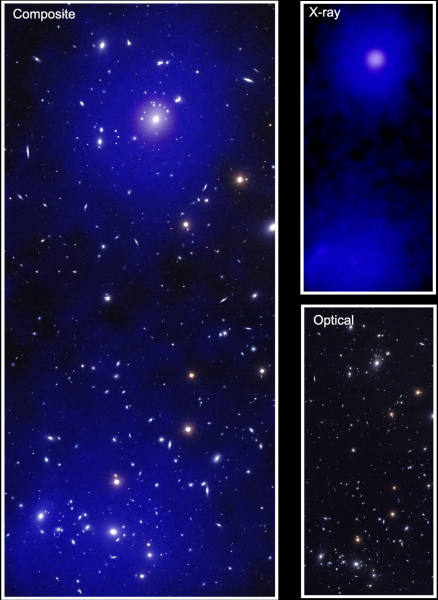Arnab Sarkar, a graduate student in the Department of Physics and Astronomy at the University of Kentucky, will present data and photos that verify, for the very first time, the existence of a shock wave formed early in the merger process between two galaxy clusters.
 Left: composite image of Abell 98. X-ray image (right top), taken by NASA's space-based X-ray telescope Chandra, overlaid the optical image (right bottom), captured by 3.5-meter WIYN telescope. Image Credit: Arnab Sarkar.
Left: composite image of Abell 98. X-ray image (right top), taken by NASA's space-based X-ray telescope Chandra, overlaid the optical image (right bottom), captured by 3.5-meter WIYN telescope. Image Credit: Arnab Sarkar.
The findings were presented on 16th June 2022 at the American Astronomical Society’s (AAS) semiannual conference in Pasadena, California.
Galaxy clusters are the universe’s largest, gravitationally bound structures. Theories indicate that when two galaxy clusters collide, the first encounter will result in a shock wave. Sarkar and his colleagues discovered an axial shock between two clusters on the verge of merging for the first time.
According to Sarkar, who is also a predoctoral scholar at the Center of Astrophysics, Harvard, and Smithsonian, this is a crucial validation in understanding how structures in the cosmos are put together.
With this discovery, we caught two sub-clusters of a galaxy cluster in a crucial early epoch of the merging process, with a strong shock between them, providing a missing link to the formation of the most massive structures in our universe.
Arnab Sarkar, Graduate Student, Department of Physics and Astronomy, University of Kentucky
The shock was discovered by the Chandra X-Ray Observatory in the Abell 98 galaxy cluster, which is more than 1,200 million light-years from Earth. Sarkar and his colleagues discovered a significant shock wave traveling at 4.5 million miles per hour between two sub-clusters, which is 20,000 times quicker than the fastest Formula 1 cars.
It is quite unusual to detect galaxy clusters early in the merger process, according to Sarkar, since they are separated by millions of light years. At the first phase of their merging, the axial shock waves envisaged by the theory were never witnessed.
The discovery of such a shock in an early-stage merging cluster was therefore a long-unsolved jigsaw puzzle in galaxy cluster formation.
Sarkar stated, “This result is important because different computer simulations seem to be telling us different things about what we should observe early on in a galaxy cluster merger. Here, we have a picture of what this process actually looks like, and that can be used to inform our theoretical models.”
On 16th June 2022, during a briefing titled “Discovery of a Pre-merger Shock Wave in Abell 98: A Missing Piece in Building the Most Massive Structures in Our Universe,” Sarkar presented his findings.
The study has been sent to the Astrophysical Journal Letters for approval.